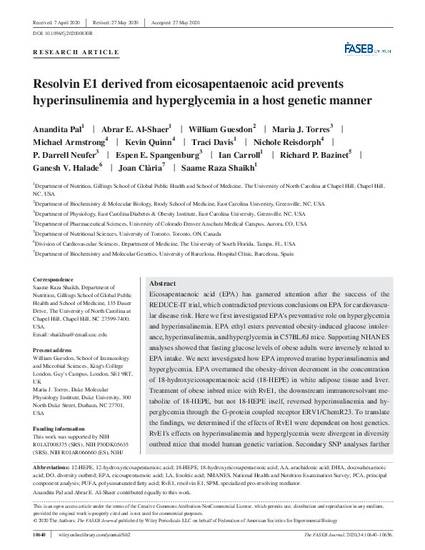
- diversity outbred mice,
- glucose,
- insulin,
- polyunsaturated fatty acids,
- specialized pro-resolving mediators
The FASEB Journal published by Wiley Periodicals LLC on behalf of Federation of American Societies for Experimental Biology Eicosapentaenoic acid (EPA) has garnered attention after the success of the REDUCE-IT trial, which contradicted previous conclusions on EPA for cardiovascular disease risk. Here we first investigated EPA's preventative role on hyperglycemia and hyperinsulinemia. EPA ethyl esters prevented obesity-induced glucose intolerance, hyperinsulinemia, and hyperglycemia in C57BL/6J mice. Supporting NHANES analyses showed that fasting glucose levels of obese adults were inversely related to EPA intake. We next investigated how EPA improved murine hyperinsulinemia and hyperglycemia. EPA overturned the obesity-driven decrement in the concentration of 18-hydroxyeicosapentaenoic acid (18-HEPE) in white adipose tissue and liver. Treatment of obese inbred mice with RvE1, the downstream immunoresolvant metabolite of 18-HEPE, but not 18-HEPE itself, reversed hyperinsulinemia and hyperglycemia through the G-protein coupled receptor ERV1/ChemR23. To translate the findings, we determined if the effects of RvE1 were dependent on host genetics. RvE1's effects on hyperinsulinemia and hyperglycemia were divergent in diversity outbred mice that model human genetic variation. Secondary SNP analyses further confirmed extensive genetic variation in human RvE1/EPA-metabolizing genes. Collectively, the data suggest EPA prevents hyperinsulinemia and hyperglycemia, in part, through RvE1's activation of ERV1/ChemR23 in a host genetic manner. The studies underscore the need for personalized administration of RvE1 based on genetic/metabolic enzyme profiles.
FASEB Journal, v. 34, issue 8, p. 10640-10656
Available at: http://works.bepress.com/ganesh-halade/68/